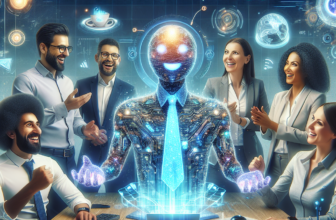Driving Change: The Power of Motivation in Fueling Innovation
Introduction
In the dynamic landscape of modern business, motivation serves as a powerful catalyst for driving change and fostering innovation. Understanding how to harness this force can determine the longevity and success of organizations. As industries evolve, the need for innovative solutions increases, making it crucial for leaders to cultivate an environment that promotes motivation among their teams.
Section 1: Understanding Motivation
What is Motivation?
Motivation can be defined as the process that initiates, guides, and maintains goal-oriented behaviors. It’s a psychological force that drives individuals to take action, achieve goals, and pursue excellence. Understanding the nuances of motivation is essential for leaders aiming to inspire their teams to embrace change and pursue innovative ideas actively.
Types of Motivation
Motivation can be categorized into two main types: intrinsic and extrinsic motivation. Intrinsic motivation is driven by internal rewards, such as personal satisfaction or the joy of performing a task. In contrast, extrinsic motivation is fueled by external rewards, such as recognition, money, or promotions. Research indicates that organizations that foster intrinsic motivation often enjoy higher levels of employee engagement and creativity.
Section 2: The Psychology of Change
Why People Resist Change
Change can be unsettling, and many individuals instinctively resist it. This resistance often arises from fear of the unknown, loss of control, or concern over potential failures. Understanding the psychological barriers to change is crucial for leaders who aim to effectively motivate their teams and encourage innovation.
Embracing Change
While resistance is natural, promoting a culture of acceptance can help demystify change. Organizations that actively engage their employees in the change process, encouraging feedback and participation, can shift perspectives and pave the way for innovation and creativity.
Section 3: The Link Between Motivation and Innovation
How Motivation Fuels Creativity
Motivation plays a vital role in promoting creativity, the lifeblood of innovation. Employees who feel satisfied and appreciated are more likely to think outside the box and contribute novel ideas. Companies like Google and Facebook have set precedents by creating work environments that emphasize collaboration, autonomy, and experimentation, fueling creativity and productivity.
Innovation Case Studies
Numerous organizations have successfully harnessed motivation to drive innovation. For instance, 3M is known for its “15% rule,” allowing employees to spend 15% of their work time on projects of their choosing, which sparked groundbreaking products like Post-it Notes. This case illustrates the dynamic interplay between motivation and innovation.
Section 4: Strategies to Enhance Motivation
Setting Clear Goals
Clear, achievable goals provide direction and a sense of purpose. When employees understand their objectives, they are more likely to stay focused and motivated. SMART (Specific, Measurable, Achievable, Relevant, Time-bound) goals are effective frameworks for guiding this process.
Reward Systems
Implementing effective reward systems can enhance motivation significantly. Recognizing and celebrating achievements, whether big or small, reinforces desired behaviors and encourages ongoing innovation. Case studies from organizations such as HubSpot demonstrate the importance of recognition programs in boosting employee morale and engagement.
Section 5: Overcoming Barriers to Motivation
Identifying Barriers
Common barriers to motivation include unclear expectations, lack of resources, and inadequate recognition. Understanding these challenges can help leaders design more effective strategies to foster a motivating work environment that encourages innovation.
Techniques to Overcome Barriers
Organizations can implement strategies such as open communication channels, regular feedback sessions, and opportunities for skill development to address these barriers. By empowering employees, leaders can create an atmosphere conducive to motivated performance and innovative output.
Section 6: The Role of Leadership
Leading by Example
Leadership sets the tone for an organization's culture. Leaders who demonstrate enthusiasm, transparency, and commitment to innovation inspire their teams to emulate similar behaviors. Creating a vision that excites and motivates employees fosters a strong connection to the company’s goals.
Creating a Supportive Environment
The physical and emotional work environment significantly impacts motivation. Leaders should strive to make workplaces engaging, inclusive, and supportive, encouraging collaboration and creativity. Space design, communication practices, and cultural values play crucial roles in this process.
Section 7: Measuring Motivation and Innovation
Metrics and KPIs
To understand how motivation influences innovation, organizations need to establish clear metrics and key performance indicators (KPIs). Employee satisfaction surveys, retention rates, and the number of innovative ideas generated are essential measures that help gauge the effectiveness of motivation strategies.
Continuous Improvement
Continuous feedback loops are vital for refining motivation strategies and innovation processes. By regularly assessing employee engagement and innovation outcomes, organizations can adapt their approaches to better meet the needs of their workforce.
Section 8: Future Trends in Motivation and Innovation
Technological Advances
Emerging technologies such as AI and machine learning are increasingly influencing the motivation landscape. Companies leveraging data analytics can personalize motivation strategies to suit individual employee preferences and behaviors. This tailored approach enhances engagement and innovation outcomes.
Societal Changes
As societal values evolve, so do expectations around workplace culture and motivation. Organizations prioritizing work-life balance, mental health, and diversity will increasingly attract motivated talent, leading to higher levels of innovation.
Q&A Section
Here are some common questions related to **Driving Change: The Power of Motivation in Fueling Innovation**:
- What are the main factors that drive employee motivation? Employee motivation is influenced by factors such as recognition, work environment, and personal growth opportunities.
- How can a company measure its motivation levels? Companies can use surveys, performance metrics, and engagement scores to evaluate employee motivation.
- Why is motivation important for innovation? Motivated employees are more likely to generate creative ideas and contribute to innovative projects.
- What role does leadership play in motivation? Leaders who embody enthusiasm and transparency can inspire their teams and drive a culture of innovation.
- How can organizations overcome resistance to change? Engaging employees in the change process and fostering open communication can help ease resistance and promote innovation.
FAQ Section
Here are five frequently asked questions:
- How does motivation impact productivity? Higher levels of motivation generally lead to increased productivity, as employees are more engaged in their work.
- What are some effective ways to motivate remote teams? Regular communication, recognition of achievements, and opportunities for skill development are effective strategies.
- How can motivation influence organizational culture? A motivated workforce contributes to a positive organizational culture that prioritizes collaboration and innovation.
- Why is understanding motivation important for leaders? Leaders who understand motivation can implement effective strategies that drive employee engagement and innovation.
- What role does feedback play in enhancing motivation? Constructive feedback helps employees understand their strengths and areas for improvement, fostering intrinsic motivation.
Resources
| Source | Description | Link |
|---|---|---|
| Harvard Business Review | Articles on motivation and psychological safety in the workplace. | Harvard Business Review |
| Psychology Today | Insights into the psychology of motivation and behavior change. | Psychology Today |
| Gallup | Research and resources on employee engagement and motivation. | Gallup |
| Forbes | Articles discussing trends in organizational motivation and innovation. | Forbes |
| TED Talks | Videos and talks on motivation and creativity in the workplace. | TED Talks |
Conclusion
Driving change through motivation is essential for fostering an innovative environment in today’s fast-paced business world. By understanding the psychology of motivation, implementing effective strategies, and overcoming barriers, organizations can unlock the full potential of their teams. Leaders play a pivotal role in shaping a culture of innovation that celebrates motivation, ultimately resulting in sustained growth and success.
Disclaimer
This article was created with assistance from artificial intelligence (AI) to enhance research and drafting efficiency. All content has been reviewed and refined by human contributors.










